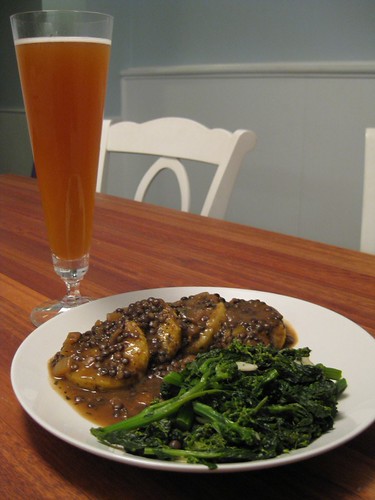One day, I hope to come up with a way to extract the gluten left in spent grain and turn it into “steak.” A lot of breweries give their spent grain to farmers to feed cattle. Why not skip the middle man? For now, however, I use store bought vital wheat gluten and a kick-ass recipe Kevin developed using bits and pieces of other recipes floating around the interwebs. Last night, I made some seitan and served it in a slightly modified version of Tim Shafer’s Stout-and-Whiskey Laced Demi-glace that was featured in the July 2007 issue of Beer Advocate magazine. I made some roasted potatoes & garlic and sauted collard greens for sides and paired with Stone Smoked Porter.
I only made minor modifications to the sauce recipe, using Jim Beam bourbon instead of scotch and my uncarbonated smoked porter instead of Irish stout. Also, I switched out the Kosher salt with smoked salt and used Earth Balance instead of butter. Here is the recipe with these modifications:
1/2 TSP. olive oil
1 white onion, diced large
10 organic whole peppercorns
2 oz Jim Beam bourbon
4 oz smoked porter
2 cups brown stock (I used Organic Better than Bouillon Vegetable Base)
1/4 TSP. smoked salt
1 TSP herbs (I used dried rosemary, parsley and thyme)
1 TBSP. Earth Balance
In a sauce pan, heat the oil and add onions and peppercorns. Cook for 5 minutes over medium heat until the onions have become tender and golden in color. Remove the pan from the stove and add bourbon. Carefully return the pan to the flame – the ALCOHOL WILL IGNITE! (since I use electric, I had to light mine with a match) Stir in the beer and cook 4-5 minutes until half of the liquid has evaporated. Add the stock and continue to simmer for 15 minutes. There should be about 1o oz remaining. Finish by straining out the onion and peppercorn, then season with herbs (note: I also strained out the herbs after infusing the sauce for about 15 minutes). Whisk in Earth Balance and set aside.
The steaks:
Dry ingredients:
1 cup vital wheat gluten
1/4 cup nutritional yeast
2 TBSP. corn meal
1 TSP. onion powder
1/2 TSP. adobo
Wet ingredients:
1/4 cup rehydrated porcini mushrooms (I usually use shiitake mushroom stems, but didn’t have any on hand)
3/4 cup water
2 TBSP. Wan Ja Shan oyster mushroom sauce
1 TBSP. olive oil
1 TBSP. tahini
1/2 TSP. Dijon mustard
1/2 TSP. truffle oil (optional)
1/4 TSP. smoked salt (optional)
Mix together the dry ingredients. Blend the mushrooms into the liquid ingredients (I use a hand blender), then mix the liquid ingredients into the dry. Form a ball, then pull off pieces and flatten into rounds.
Normally, the seitan is baked for about 10 minutes in an oven at 350 degrees, flipped and basted, then returned to the oven for another 15 minutes or so. I wanted to give the steaks a smokey flavor, so I decided to cook the seitan in my smoker for the first 10 minutes, setting the grill to low heat. I used about 1/2 cup of the demi-glace as the basting sauce and returned the steaks to the grill in a baking dish on low heat for another 15 minutes or so, until most of the liquid was gone and the steaks were firm.

For the sides, I sliced about about 6 medium sized organic red potatoes and about 6-8 cloves of garlic, placed them in an oiled baking dish with 1/2 cup of light stock, black pepper and a pinch of smoked salt. Baked at 350 for about an hour. I sauted the greens in olive oil with a little pepper.

Everything came out great. The bourbon and porter gave the sauce a sweet toasty flavor, wihtout the boozy character you might expect. The texture of the steaks was perfect. I feared they would come out too doughy, which has happened in past efforts to grill seitan. The mushrooms give the seitan an earthy flavor, which removes the grainy gluten taste you get in most seitan recipes. It has a smooth smokey flavor, but it’s not an overpowering bacon-like taste. My wife Jaime, who does not care for bourbon or smoked beer, found the sauce to be really tasty. In fact, she even had some smoked porter with the meal, as it complimented the sweet smokey flavors of the food nicely. The only complaint we both had was it was a touch too salty. I probably could have left out some of the smoked salt and adobo and maybe reduced the amount of Better than Bouillion I used to make the broth. Overall, a great steak and potatoes meal.





